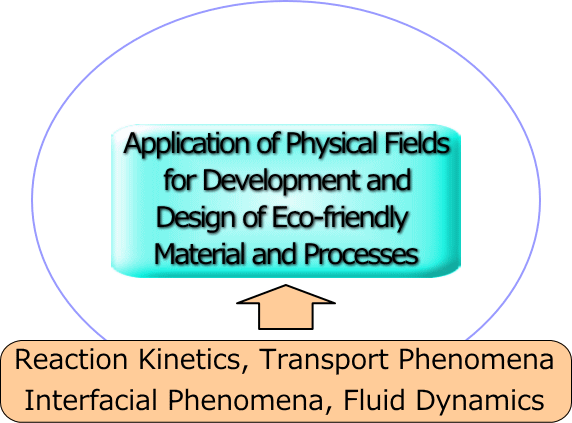Research
Our laboratory focusses on developing and designing eco-friendly materials and processes using physical fields, and on elucidating the effects of these fields on the reaction kinetics, transport and interface phenomena.
Examples of such fields include ultrasonic and electromagnetic fields, microwaves and plasma.
Some advantages of this approach are : (1) minimization of chemical waste, (2) reduction of process temperature, (3) improvement of material recyclability.
The main aim of this study is to investigate formation mechanisms and key factors influencing behavior of vortex rotation flows. The study includes two stage:dimensionless analysis based cold model experimentation and CFD numerical simulation. The goal of the first part is to investigate the main factors influencing the behavior of vortex rotation flow on the surface and in the bulk of liquid bath, and effects of the flow on the penetration of particles from the liquid surface into the bath and agitation characteristics of liquid bath. The factors include vessel design, impeller design and location, impeller shaft inclination and rotation speed. The second part of the study is performed aiming at elucidating mechanisms of vortex formation and its-resulting flow pattern inside the liquid bath. The main outcome of the first and second stages is expected to be an experimentally verified mathematical model capable of predicting flow pattern in the melt bath of smelters and refining units of industrial scale.
Some advantages of this approach are : (1) minimization of chemical waste, (2) reduction of process temperature, (3) improvement of material recyclability.
Unsteady Flows
Improvement in efficiency of molten aluminum agitation and degassing by using vortex rotation flow
Production of secondary aluminum involves scrap and/or ingot remelting and melt refining which typically include degassing and impurity removal.
In these processes, both the melt agitation and gas injection are the key technological factors influencing the melt homogeneity and residual concentration of impurities.
Obviously, the melt agitation and gas injection should be performed in such a way as to ensure uniform and complete agitation of melt, and uniform distribution of gas bubbles over the melt bath.
Therefore, the melt flow pattern and gas bubble behavior are extremely important in increasing the efficiency of refining operation. Particularly, impeller rotation results in formation of vortex rotation flows on the melt bath surface and inside of it.
Formation of vortex rotation flows on the melt surface, for example, is desirable to ensure a better stirring of flux particles into a melt during the melt flux treatment.
On the other hand, the surface vortex formation must be suppressed during degassing and homogenizing operations.
Instead, in order to improve the melt agitation and gas bubble distribution, these operations need a vortex flow to occur inside the melt bath.The main aim of this study is to investigate formation mechanisms and key factors influencing behavior of vortex rotation flows. The study includes two stage:dimensionless analysis based cold model experimentation and CFD numerical simulation. The goal of the first part is to investigate the main factors influencing the behavior of vortex rotation flow on the surface and in the bulk of liquid bath, and effects of the flow on the penetration of particles from the liquid surface into the bath and agitation characteristics of liquid bath. The factors include vessel design, impeller design and location, impeller shaft inclination and rotation speed. The second part of the study is performed aiming at elucidating mechanisms of vortex formation and its-resulting flow pattern inside the liquid bath. The main outcome of the first and second stages is expected to be an experimentally verified mathematical model capable of predicting flow pattern in the melt bath of smelters and refining units of industrial scale.

